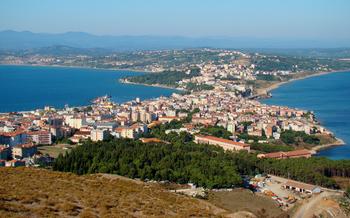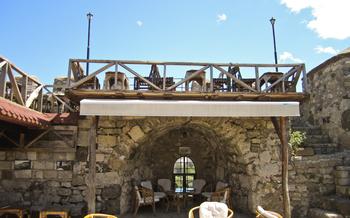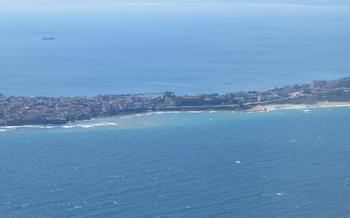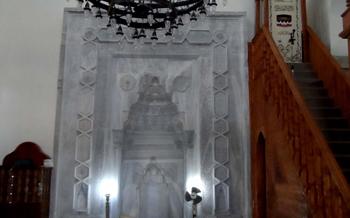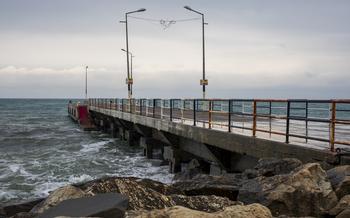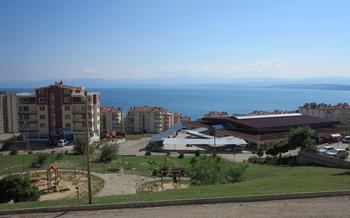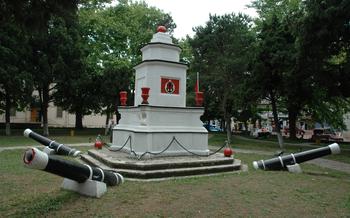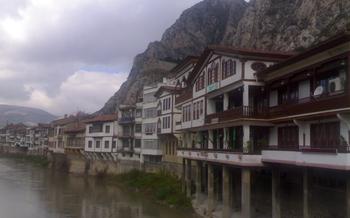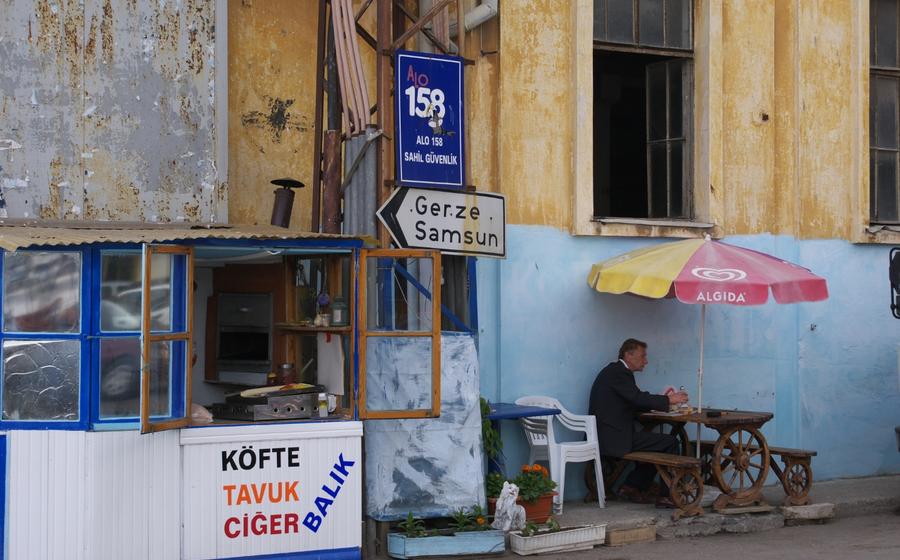
Sinop University Observatory
- Historical Background
- Location and Accessibility:
- Visiting Information
- Telescopes and Equipment
- Observing Sessions
- Educational Programs
- Research Activities
- Astrophotography Opportunities
- Night Sky Tours: Unveiling the Secrets of the Cosmos
- Space Exhibitions
- Souvenirs and Merchandise
- Accessibility for Visitors with Disabilities:
- Nearby Attractions and Activities
- Volunteering Opportunities
- Insider Tip:
Historical Background
The Sinop University Observatory stands as a testament to Turkey's rich history in scientific research and astronomy. Established in 1972, the observatory has played a pivotal role in advancing the frontiers of knowledge in these fields. Its contributions have been instrumental in shaping the landscape of astronomy in Turkey, fostering a vibrant community of researchers and enthusiasts.
Throughout its existence, the observatory has been associated with notable astronomers and scientists who have dedicated their lives to unlocking the mysteries of the cosmos. Among them, Professor Dr. Ahmet Yılmaz stands out as a pioneer in the field of astrophysics. His groundbreaking research on stellar evolution and the formation of galaxies has earned him international recognition and acclaim.
Over the years, the observatory has witnessed numerous significant discoveries and achievements. In 1987, astronomers at the observatory observed a rare celestial event—a supernova in the neighboring galaxy M8This observation provided valuable insights into the final stages of a star's life cycle and the formation of elements heavier than iron.
The observatory's historical significance extends beyond its scientific achievements. It serves as a symbol of Turkey's commitment to scientific research and education. Its doors are open to the public, offering visitors a chance to explore the wonders of the universe and ignite their passion for astronomy.
Location and Accessibility:
The Sinop University Observatory is conveniently located in the heart of Sinop, Turkey, offering easy access for visitors. Situated on the scenic Black Sea coast, the observatory is just a short distance from the city center and can be reached via various transportation options. Whether you're driving, taking public transportation, or joining a guided tour, getting to the observatory is a breeze. For those driving, the observatory provides ample parking space, ensuring a hassle-free visit. For those relying on public transportation, regular bus routes connect the city center to the observatory, making it easily accessible for all. Additionally, guided tours are available for those who prefer a more comprehensive and informative experience. To plan your visit and find the best route to the observatory, refer to the detailed map and directions provided on the observatory's website.
Visiting Information
Visiting the Sinop University Observatory is an enlightening and captivating experience open to the public. The observatory's doors are open to astronomy enthusiasts, students, and the general public on specific days and hours. To ensure a seamless visit, it is advisable to check the observatory's website or contact them directly for the most up-to-date information regarding operating hours and any potential closures.
Admission to the observatory is typically free of charge, allowing visitors to explore the wonders of the cosmos without any financial burden. Furthermore, guided tours are often organized by the observatory's knowledgeable staff, providing visitors with an in-depth understanding of the celestial wonders they are about to witness. These tours are an excellent opportunity to learn about the history, equipment, and research conducted at the observatory, as well as to ask questions and gain insights from the experts.
For an optimal observing experience, it is recommended to visit the observatory on a clear night, away from the city lights that can hinder visibility. The best time to visit is during the summer months, when the weather conditions are generally more favorable for stargazing. However, each season offers its unique charm, with different celestial objects visible at various times of the year.
Telescopes and Equipment
The Sinop University Observatory boasts an impressive array of telescopes and equipment, catering to both research and educational purposes. Its primary telescope, a 14-inch Schmidt-Cassegrain reflector, offers exceptional views of the night sky with its large aperture and advanced optics. The observatory also houses several smaller telescopes, including a 10-inch Dobsonian reflector and a 6-inch refractor, providing visitors with a variety of options for celestial observations.
Beyond its telescopes, the observatory is equipped with state-of-the-art imaging systems, spectrographs, and photometers. These instruments enable researchers to capture detailed images of celestial objects, analyze their chemical composition, and measure their brightness and variability. The observatory's facilities also include a computer lab and a library, providing researchers and students with access to the latest software, databases, and astronomical literature.
The Sinop University Observatory's telescopes and equipment play a crucial role in advancing astronomy and astrophysics research in Turkey. Researchers utilize these tools to study a wide range of astronomical phenomena, including star formation, planetary systems, and the evolution of galaxies. The observatory's facilities also serve as a valuable resource for students, allowing them to gain hands-on experience with astronomical instruments and conduct their own research projects.
Observing Sessions
Visitors to the Sinop University Observatory can participate in guided observing sessions led by experienced astronomers. These sessions are an excellent opportunity to learn more about the night sky and the wonders of the universe. To book an observing session, visitors can either make a reservation online or inquire at the observatory's visitor center.
During the observing sessions, astronomers use the observatory's telescopes to showcase various celestial objects, including planets, stars, galaxies, and nebulae. Visitors can marvel at the beauty of Saturn's rings, witness the stunning colors of the Orion Nebula, or explore the vastness of the Milky Way galaxy. The astronomers provide detailed explanations and answer questions, helping visitors to understand the observed objects and the science behind them.
Observing sessions are usually conducted on clear evenings, and the best time to visit is during the summer months when the weather is warm and the nights are long. Visitors are encouraged to dress warmly and bring a flashlight or headlamp for navigating the observatory grounds. Binoculars or a small telescope can also enhance the viewing experience, but they are not necessary.
Educational Programs
The Sinop University Observatory offers a range of educational programs and workshops designed to engage and inspire people of all ages in the wonders of astronomy and space exploration. These programs cater to various target audiences, including students, educators, hobbyists, and the general public.
The observatory's educational offerings include:
-
School Programs: Designed for school groups of all levels, these programs provide interactive learning experiences aligned with science curricula. Students can explore topics such as the solar system, stars, galaxies, and the history of astronomy through hands-on activities, demonstrations, and guided observations.
-
Public Workshops: Open to the general public, these workshops cover a wide range of astronomy-related topics, including astrophotography, telescope making, and the latest discoveries in space science. Participants can learn from experienced astronomers and engage in discussions with like-minded enthusiasts.
-
Summer Camps: During the summer months, the observatory hosts astronomy-themed summer camps for children and teenagers. These camps offer a fun and educational environment where participants can learn about astronomy, conduct experiments, and participate in observing sessions.
-
Teacher Training Programs: The observatory provides training programs for educators who wish to incorporate astronomy into their teaching. These programs equip teachers with the knowledge and resources they need to effectively teach astronomy in the classroom.
The observatory's educational programs have a proven track record of success, with many participants expressing their newfound appreciation for astronomy and the universe. These programs play a vital role in fostering scientific literacy, inspiring the next generation of astronomers, and promoting public engagement with astronomy.
Research Activities
The Sinop University Observatory is not just a place for observing the night sky; it is also a hub for cutting-edge research in astronomy and astrophysics. Researchers at the observatory are engaged in a wide range of projects, from studying the formation and evolution of stars and galaxies to investigating the mysteries of the universe's expansion.
One of the observatory's primary research areas is planetary science. Researchers use the observatory's telescopes to study the planets in our solar system, as well as planets orbiting other stars, known as exoplanets. They observe these celestial bodies to understand their physical characteristics, such as their size, mass, and composition, as well as their atmospheres and surface features.
Another area of research at the observatory is stellar evolution. Researchers study the birth, life, and death of stars, using the observatory's telescopes to observe stars at different stages of their evolution. They investigate how stars form from clouds of gas and dust, how they fuse elements in their cores to produce energy, and how they eventually end their lives as supernovae or white dwarfs.
The observatory also conducts research in cosmology, the study of the universe as a whole. Researchers use the observatory's telescopes to observe distant galaxies and quasars to understand the universe's structure and evolution. They study the cosmic microwave background radiation, the remnant radiation from the Big Bang, to learn about the universe's early moments.
The Sinop University Observatory's research activities contribute significantly to the advancement of scientific knowledge and understanding of the universe. The observatory's researchers have made notable discoveries, such as the detection of new exoplanets, the measurement of the mass of black holes, and the study of the cosmic microwave background radiation.
Through their research, the observatory's scientists are helping to unravel the mysteries of the universe and pushing the boundaries of our knowledge.
Astrophotography Opportunities
The Sinop University Observatory offers exceptional opportunities for astrophotography enthusiasts to capture stunning images of the cosmos. Visitors can bring their own equipment, including telescopes, cameras, and tripods, to take advantage of the observatory's dark skies and advanced facilities. The observatory staff is available to provide guidance and assistance to photographers of all skill levels.
Before embarking on an astrophotography session, it is essential to understand the basics of the craft. Visitors should familiarize themselves with the equipment they will be using and the techniques required for successful astrophotography. The observatory offers workshops and seminars on astrophotography, which can provide valuable insights and hands-on training.
To capture the best possible images, visitors should plan their observing sessions carefully. The time of year, weather conditions, and moon phase all play a crucial role in determining the visibility and clarity of celestial objects. The observatory staff can provide advice on the best times to observe specific objects and can help visitors choose the right equipment for their needs.
With patience, dedication, and the right equipment, visitors to the Sinop University Observatory can create breathtaking astrophotography images that will capture the wonders of the universe. The observatory's dark skies and state-of-the-art facilities provide an ideal setting for astrophotographers to explore the cosmos and capture its beauty through the lens of a camera.
Night Sky Tours: Unveiling the Secrets of the Cosmos
Immerse yourself in the celestial wonders of the night sky during a guided stargazing session at the Sinop University Observatory. These tours, led by experienced astronomers, offer a captivating journey through the vast expanse of the universe.
With state-of-the-art telescopes and laser pointers, visitors embark on an exploration of the cosmos, uncovering the mysteries of planets, stars, galaxies, and nebulae. Learn about the constellations, identify celestial objects, and delve into the fascinating stories behind their formation and evolution.
The night sky tours are designed for visitors of all ages and levels of astronomical knowledge. Whether you're a seasoned stargazer or a curious beginner, the observatory's knowledgeable guides will ensure an informative and engaging experience.
As darkness envelops the observatory, the night sky comes alive with a myriad of celestial wonders. Marvel at the shimmering brilliance of the Milky Way, spot shooting stars streaking across the sky, and witness the awe-inspiring beauty of distant galaxies.
Don't miss this opportunity to connect with the cosmos and experience the magic of the night sky at the Sinop University Observatory.
Space Exhibitions
The Sinop University Observatory features a range of captivating space-themed exhibitions that offer visitors an immersive journey into the wonders of the cosmos. Through interactive displays, models, and historical artifacts, these exhibitions provide an educational and engaging experience for visitors of all ages.
One of the highlights of the exhibitions is the interactive planetarium, where visitors can embark on a virtual tour of the solar system and explore the vastness of space. The planetarium offers shows and presentations that delve into the mysteries of the universe, captivating audiences with stunning visuals and informative narration.
Another popular exhibit is the collection of meteorites and space rocks. Visitors can marvel at these extraterrestrial wonders, which have traveled vast distances to reach our planet, and gain insights into the formation and evolution of our solar system.
The observatory also showcases a collection of historical artifacts, including vintage telescopes, scientific instruments, and photographs. These artifacts provide a glimpse into the history of astronomy and the pioneering work of scientists who have dedicated their lives to unlocking the secrets of the universe.
Whether you're a seasoned astronomer or simply curious about the cosmos, the Sinop University Observatory's space exhibitions offer a wealth of knowledge and inspiration. Take advantage of this opportunity to explore the wonders of the universe and gain a deeper understanding of our place in it.
Souvenirs and Merchandise
The Sinop University Observatory has a small gift shop that offers a variety of souvenirs and merchandise for visitors to take home. These items not only serve as mementos of a visit to the observatory but also contribute to its research and educational programs.
Among the souvenirs available are books on astronomy and space exploration, posters of celestial objects and galaxies, postcards featuring images taken at the observatory, and a range of space-themed merchandise such as t-shirts, mugs, and keychains.
By purchasing souvenirs from the observatory's gift shop, visitors not only take home a tangible reminder of their experience but also contribute to the observatory's ongoing research and educational activities. The proceeds from souvenir sales help fund projects, maintain equipment, and support the observatory's mission of promoting astronomy and science education.
Accessibility for Visitors with Disabilities:
The Sinop University Observatory recognizes the importance of accessibility for visitors with disabilities. It strives to create an inclusive environment that allows everyone to enjoy the wonders of astronomy and space exploration. The observatory is wheelchair accessible, featuring ramps and elevators to ensure easy navigation throughout the facility. Designated parking spaces are available close to the entrance for visitors with disabilities. The observatory staff is dedicated to providing assistance to visitors with disabilities, ensuring a comfortable and enjoyable experience for all. They are always ready to assist with any special needs or requests to make the visit as smooth and memorable as possible. Visitors with disabilities who have visited the observatory have expressed their gratitude for the thoughtful accessibility features and the supportive staff, making their visit an enjoyable and educational experience.
Nearby Attractions and Activities
The Sinop University Observatory is not just an isolated destination; it is surrounded by a wealth of other attractions and activities that visitors can explore. History buffs can delve into the rich past of Sinop by visiting the Sinop Castle, a formidable fortress built by the Romans and later expanded by the Byzantines and Ottomans. Nature enthusiasts will find solace in the lush forests of İnceburun Peninsula, home to a diverse array of flora and fauna. For those seeking a refreshing dip, the golden sands of Akliman Beach beckon, offering picturesque views and crystal-clear waters.
To make the most of your time in Sinop, consider combining your visit to the observatory with these other nearby attractions. You can embark on a day trip that starts with an exploration of the Sinop Castle, followed by a leisurely hike through the İnceburun Peninsula. As the sun begins to set, head to the observatory to witness the celestial wonders of the night sky. Alternatively, spend a relaxing day at Akliman Beach, soaking up the sun and swimming in the azure waters. As evening approaches, return to the observatory for an unforgettable night sky tour.
No matter how you choose to spend your time in Sinop, the Sinop University Observatory is a must-visit destination that promises an enriching and awe-inspiring experience. So, prepare to be captivated by the cosmos and the beauty of the natural world that surrounds this remarkable observatory.
Volunteering Opportunities
The Sinop University Observatory offers exciting volunteering opportunities for individuals passionate about astronomy and science outreach. By becoming a volunteer, you can contribute to the observatory's mission and gain valuable hands-on experience in the field. Volunteers play a crucial role in assisting with observing sessions, educational programs, and research projects, helping to make the observatory a dynamic and accessible resource for the community.
There are various volunteer positions available, catering to diverse interests and skills. Whether you are a student eager to learn more about astronomy, a retired professional looking to share your expertise, or simply someone with a passion for science and education, the observatory welcomes volunteers from all backgrounds.
As a volunteer, you will have the opportunity to work alongside experienced astronomers and educators, gaining insights into the latest research and discoveries in the field. You will also contribute to the observatory's educational outreach efforts, helping to inspire the next generation of scientists and astronomers.
If you are interested in volunteering at the Sinop University Observatory, please contact the observatory staff for more information. They will be happy to discuss the available positions and guide you through the application process. Volunteering at the observatory is a rewarding and fulfilling experience that allows you to make a meaningful contribution to the advancement of astronomy and science education.
Insider Tip:
For an unforgettable experience, plan your visit to the Sinop University Observatory during one of its special observing nights. These events offer visitors the chance to peer through the telescopes and witness celestial wonders like meteor showers, comet transits, or the aurora borealis. Check the observatory's website or social media pages for upcoming observing nights and prepare to be amazed by the cosmos.
